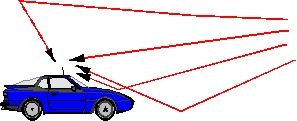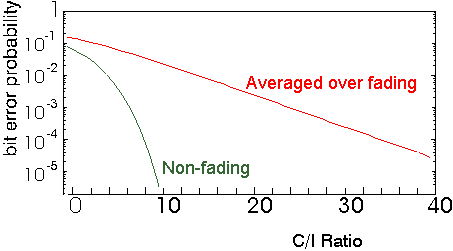
 |
JPL's Wireless Communication Reference WebsiteChapter: Wireless Channels
|
 The
mobile or indoor radio channel is characterized by 'multipath reception': The
signal offered to the receiver contains not only a direct line-of-sight
radio wave, but also a large number of reflected radio waves. Even worse in
urban centers, the line-of-sight is often blocked by obstacles, and a collected
of differently delayed waves is all what is received by a mobile antenna. These
reflected waves interfere with the direct wave, which causes significant degradation
of the performance of the link. If the antenna moves the channel varies with
location and time, because the relative phases of the reflected waves change.
This leads to fading: time variations of the received amplitude and phase.
The
mobile or indoor radio channel is characterized by 'multipath reception': The
signal offered to the receiver contains not only a direct line-of-sight
radio wave, but also a large number of reflected radio waves. Even worse in
urban centers, the line-of-sight is often blocked by obstacles, and a collected
of differently delayed waves is all what is received by a mobile antenna. These
reflected waves interfere with the direct wave, which causes significant degradation
of the performance of the link. If the antenna moves the channel varies with
location and time, because the relative phases of the reflected waves change.
This leads to fading: time variations of the received amplitude and phase.
 In
a non-fading (thus fixed) radio channel the BER decreases rapidly when the signal-to-noise
(or signal-to-interference) ratio is increased. In a fading channel, every
now and then the received signal is very weak and many bit errors occur.
This phenomenon remains present, even if the (average) signal-to-noise ratio
is large. So the BER only improves very slowly, and with a fixed slope, if plotted
on a log-log scale. (Diversity
or error correction can help to make the slope steeper, hence improve performance.)
In
a non-fading (thus fixed) radio channel the BER decreases rapidly when the signal-to-noise
(or signal-to-interference) ratio is increased. In a fading channel, every
now and then the received signal is very weak and many bit errors occur.
This phenomenon remains present, even if the (average) signal-to-noise ratio
is large. So the BER only improves very slowly, and with a fixed slope, if plotted
on a log-log scale. (Diversity
or error correction can help to make the slope steeper, hence improve performance.)
A wireless system has to be designed in such way that the adverse effect of multipath fading is minimized. In the past, multipath has notoriously hindered the development of reliable and inexpensive mass-product systems. A better understanding of these phenomena, and the advent of powerful signal processing techniques contributed to the explosion of digital wireless communication since the 1980s.
 | The basic model of Rayleigh fading assumes a received multipath signal to consist of a (theoretically infinitely) large number of reflected waves with independent and identically distributed inphase and quadrature amplitudes. This model has played a major role in our understanding of mobile propagation. The model was first proposed in a comment paper written by Lord Rayleigh in 1889, describing the resulting signal if many violinists in an orchestra play in unison, long before its application to mobile radio reception was recognized. | Lord Rayleigh, "On the resultant of a large number of vibrations of the same pitch and of arbitrary phase", Phil. Mag., Vol. 10, August 1880, pp. 73-78 and Vol. 27, June 1889, pp. 460-469. |
More recently, this model of many randomly phased sinusoids appeared to appropriately describe the wireless radio channel, and to allow calculation of outage probabilities, fade durations and many other critical parameters of wireless links. It greatly facilitated the development systems that can reliably communicate despite the anomalies and unpredictability of the mobile communication channel.
As the demand for mobile communication increases, systems have to be more efficient and cell sizes are chosen smaller and smaller. To describe microcellular propagation, the Rayleigh model lacked the effect of a dominant line-of-sight component, and Rician model appeared to be more appropriate.
Most conventional digital modulation techniques are sensitive to intersymbol interference unless the channel symbol rate is small compared to the delay spread of the channel. On the other hand a narrowband signal with bit durations much longer than the delay spread may vanish completely in fade. A signal received at a frequency and location where reflected waves cancel each other, is heavily attenuated and may thus suffer large bit error rates.
| for a fast moving user: | rapid fluctuations of the signal amplitude and phase | ||
| for a wideband (digital) signal: | dispersion and intersymbol interference | ||
| for an analog television signal: | "ghost" images (shifted slightly to the right) | ||
| for a MultiCarrier signal: | different attenuation at different (sub-)carriers and at different locations | ||
| for a stationary user of a narrowband system: | good reception at some locations and frequencies; poor reception at other locations and frequencies. | ||
| for a satellite positioning system: | strong delayed reflections may cause a severe miscalculation of the distance between user and satellite. This can result in a wrong "fix", i.e., a wrong estimate of the position. |